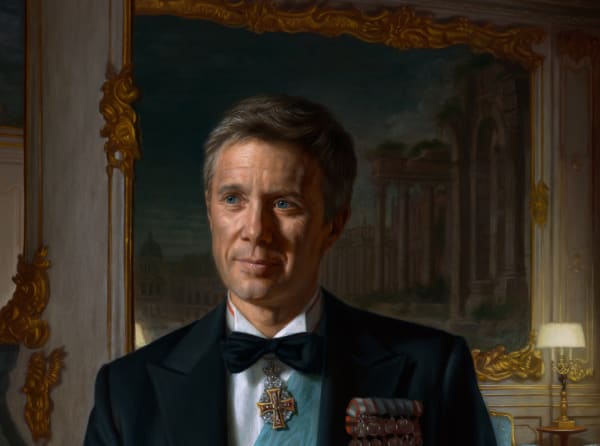-

-
Portrait of a Crown Prince
By Thomas LyngbyTo celebrate the 50th birthday of HRH Crown Prince Frederik in 2018, the Museum of National History commissioned a new portrait of the heir to the throne. Ralph Heimans was a natural choice for the project. The challenge was to create a work that would be a counterpart to the portrait of HRH Crown Princess Mary, which the Australian-born artist had previously painted for the Museum in 2006.
In conceiving of the new work, the artist realised that the portraits would need to interlock compositionally – a mirror image of mirror images – a conundrum of sorts, especially since so many elements of the room had already been altered in Princess Mary’s portrait.
Both works are set in the famous Garden Room at Fredensborg Palace and are the same size. But where the Crown Princess is seen standing on the right-hand side of her portrait, the Crown Prince is depicted on the left-hand side of his, so the two works when seen together create an entity. By making the underlying mood of each work complimentary, the artist is using both works to make a narrative statement, not just about each individual, but also about the couple as a unit.
Moreover, the years that separate the creation of the two portraits are also reflected in the new work. The painting reveals what has happened in the intervening time, and the status of the Crown Prince’s life now at the age of 50.
The Crown Prince seems to have risen from the chair at the table next to him. On the table there is a folder with his monogram. But as with the best of Heimans’ work, there is the suggestion of narrative beyond the picture frame. The Crown Prince is stepping forward and looks ahead with the hint of a smile on his lips. His gaze does not meet ours but we can see what the Crown Prince is looking at. As in the portrait of Crown Princess Mary, Heimans has replaced some of Jacopo Fabris’ recessed paintings in the Garden Room with mirrors, but this time they show the present and indeed the future rather than the past. In front of the Crown Prince, reflected in the mirror are the Crown Princess, dressed in an evening gown, and their four children gathered around a table. The oldest child, Prince Christian is standing, resting one arm on the back of a chair and looking towards his father.
Behind the family we can follow the Crown Prince’s gaze further, out of two of the room’s windows to the Palace Garden. We see trees, Johannes Wiedewelt’s great marble monument symbolizing the Danish Nation and Brede Allé, the gardens main axis. There is an evening sky over the landscape with the distinctive colours and clouds, so characteristic of Denmark.
Heimans has not replaced all the paintings with mirrors. But in his portrayal, the artist is more loyal to the story of the Crown Prince than to Fabris’ original works. So in one of them – on the far left – he has discreetly depicted the Crown Prince’s mother, Her Majesty the Queen, wearing a long, dark red dress. From her position beneath the painting’s antique, triumphal arch-like portal, like us, unnoticed, she quietly observes her son and his family.
In front of the painting in which the Queen is portrayed, there is a table, on which Heimans has placed two Greenlandic tupilaqs. Together with Wiedewelt’s Denmark monument outside, they indicate the kingdom over which the Crown Prince one day will reign.
There is a sense of completeness in this portrait – The Crown Prince is seen surrounded by his immediate family: the children who have come into the world since his marriage to the Crown Princess, whose background and transformation were depicted in the earlier portrait. The Crown Prince is perceived as part of the order of succession, which is his innate destiny. From the picture with the historic scenery his mother observes him, while he can look ahead at his eldest son who one day will succeed him. The three of them are subtly linked with the artist’s choice of colour, which moves the eye through the composition, accentuating the depth of perspective he has skilfully created.
In the new portrait the Crown Prince is wearing the Danish Navy’s company uniform. He is carrying the cap in his left hand and a pair of white gloves in his right, mirroring also Princess Mary’s portrait in this small but significant detail, which hints at their Royal duties. He is wearing the Order of the Elephant on the blue ribbon that hangs from his left shoulder, and around his neck is the Grand Commander Cross of the Order of the Dannebrog. On the uniform’s jacket we also see the chest star of the Order of the Elephant and the Dannebrog Star, along with a number of medals.
Here is 50-year-old Crown Prince Frederik in his life and in his role as the heir to the throne. He has assumed the responsibility of being the future ruler of Denmark, the Faroe Islands and Greenland, and he performs his duties together with the family he has created with the Crown Princess. His eldest son, Prince Christian, will one day succeed him. Through the portrait we are afforded a glimpse of this family in the royal setting of Fredensborg, at a moment in the early evening, an interplay between their public and private roles.






